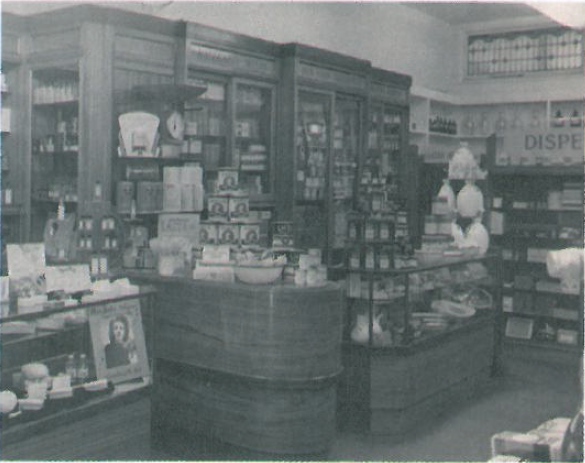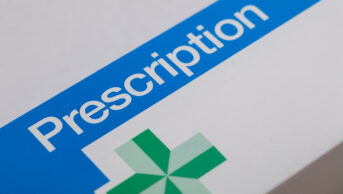
Source: Museum of the Royal Pharmaceutical Society
This content was published in 2008. We do not recommend that you take any clinical decisions based on this information without first ensuring you have checked the latest guidance.
In the 1950s, few pharmacists had degrees so there were few, if any, postgraduate students. Most students worked for at least two years in a pharmacy as an apprentice before two years’ study at college leading to the qualifying examination.
My apprenticeship was served in the New Street, Huddersfield, branch of Timothy Whites and Taylors Ltd (TWT). TWT had a network of smallish shops. It ran a kind of correspondence course for apprentices but I was also taught by the pharmacy manager. I had to keep a record of what I learnt in a book that was examined by the area manager and by the Pharmaceutical Society inspector.
Prescriptions were in abbreviated Latin and many drugs on the shelves were labelled in Latin. Although this was a bit different from the Latin I had studied for my School Certificate, I found it fairly easy. However, I also had to learn a different system of weights and measures. Medicines were prescribed and made up using the apothecary’s ounce of 480 grains. This could be divided into 8 drachms of 60 grains each. The fluid ounce could also be divided into 8 fluid drachms and 480 minims or drops. However when we sold drugs or other items we used the imperial ounce (oz) of 437.5 grains. The most prescribed items were mixtures. These often were kept ready prepared in half-gallon bottles known as Winchesters and included: Mist Ammon et Ipecac, Mist Ammon Chlor et Morph, Mist Pot Brom et Ntrx Vom and Mist Mag Carb Aromat. The formulae for these would be in the National Formulary (not then bearing the adjective British). Most consisted of simple chemicals, such as sodium bicarbonate, ingredients of vegetable origin, such as tincture of ipecacuanha, and an aqueous liquid to make up the volume.
The morph(ine) item in some mixtures was supplied as chlorodyne (tincture of chloroform and morphine). The aqueous component could be tap water, but was often a flavoured water, such as chloroform water. A solution of chloroform in water was tricky to prepare because chloroform is almost insoluble in water. The required amount of chloroform was carefully measured and poured into a bottle and an approximately equal amount of water added. The bottle was then shaken until the two were well mixed, when a further supply of water was added, followed by further shaking, so that the chloroform was split into small droplets. The process of adding water and shaking continued, until the chloroform had dissolved, when it was made up to volume with water.
Peppermint water was another flavoured water prepared in the dispensary. A quantity of talc was weighed out and placed in a mortar. The required amount of oil of peppermint was added and thoroughly mixed in using a pestle, so that the oil had been absorbed by the talc. Water was then added and thoroughly mixed. The mixture was transferred to an 80fl oz bottle and made up to volume with more water. The final stage was filtering through to remove the talc to give a clear, aqueous liquid, smelling and tasting of peppermint. Many proprietary mixtures, such as Metatone, Minadex, and Benylin, were also available in 80fl oz bottles for dispensing.
Ointments and creams were popular. Those in the National Formulary were obtained in 1lb quantities from the wholesaler but many prescribers had their own ideas, so many had to be made in the dispensary, usually by mixing the ingredients on an ointment slab with a spatula. Tar in various forms was often prescribed in ointments. Ointments were often dispensed in wax cartons if fairly stiff, otherwise they were put in glass jars.
The only antibiotic available was penicillin. In addition to penicillin for injection in various strengths, dispensed with an equal number of vials of water for injections penicillin lozenges and penicillin ointment were available. Penicillin cream and eye drops were prepared in the dispensary. We also dispensed fairly large quantities of “sulpha” drugs (eg, sulphathiazole) — the most effective treatments for many conditions until antibiotics had become available. Many of these were in tablet form and made by May & Baker. The company’s initials were stamped into the tablets so they were known to the public as “M & B’s”. Other tablets we dispensed included codeine, aspirin, digitalis, and “thyroid”. As well as ordinary aspirin tablets, we stocked yellow and red ones, which some people believed to be stronger than the white ones.
When the prescription had been prepared it was labelled “The Mixture” or “The Tablets”, as appropriate (and never with the actual name of the preparation), the dose or the words “take/use as directed” and the patient’s name and the date of dispensing. We had a large selection of pre-printed labels, so it was usually only necessary to write a date and the patient’s name. Sometimes we added a label asking the patient to return the container after use, so although recycling was not talked about in those days it was often practised. The completed prescription was then wrapped in white paper (“white demy”) and the parcel sealed with a dab of red sealing wax, the object being to seal the parcel without any wax showing.
As well as working in the dispensary, I served on the medicines counter. Apart from packed drugs, such as boric acid, sodium bicarbonate and cream of tartar, we also sold liquid paraffin, malt extract with cod liver oil, and zinc and castor oil cream to be rubbed into a child’s posterior, before putting on a towelling nappy. Two popular remedies were prepared and packed in our dispensary: “oil of almonds, syrup of violets and syrup of squills” and “olive oil and raspberry vinegar”. Although the second sounds like a salad dressing, I believe both were used for children’s coughs. As the oils did not mix with the other ingredients, it was necessary to shake the bottle each time a dose was poured.
In those days sex education in schools was just about non-existent and my parents were not particularly forthcoming. However, I was expected to sell contraceptives. The firm were not very helpful either. The only information I was given about these products was that the sale must be handled discreetly and the items wrapped before handing to the customer.
In a small photographic section we stocked a few cheap cameras and various black and white films. These came in various sizes, 828, 127, 120, 620 and 35mm. We also took in customers’ films for developing and printing. Prints were normally contact prints (ie, the same size as the negative) Anything bigger counted as an enlargement.
Since the 1939-45 war had ended only a few years earlier, we still had quite large sales of saccharin — popularised during the war as a substitute for sugar. In autumn, we sold pickling spice and turmeric. In winter, remedies to prevent or treat chilblains were good sellers as were hot water bottles because few houses had central heating. The sales were all in cash, using pre-decimal currency. Our till totalled the amount to be paid but did not tell how much change to give, so proficiency at mental arithmetic was necessary. A small number of items were individually priced but normally each shelf or drawer would have a card with a list of items and the retail prices.
After two years I went on to college. Although TWT had an examination for their apprentices, there was no official Society one. I had learnt a lot and was to learn much more in the next two years but by the time I had retired, it was almost all obsolete.
Philip Crabtree is a retired pharmacist in Huddersfield


